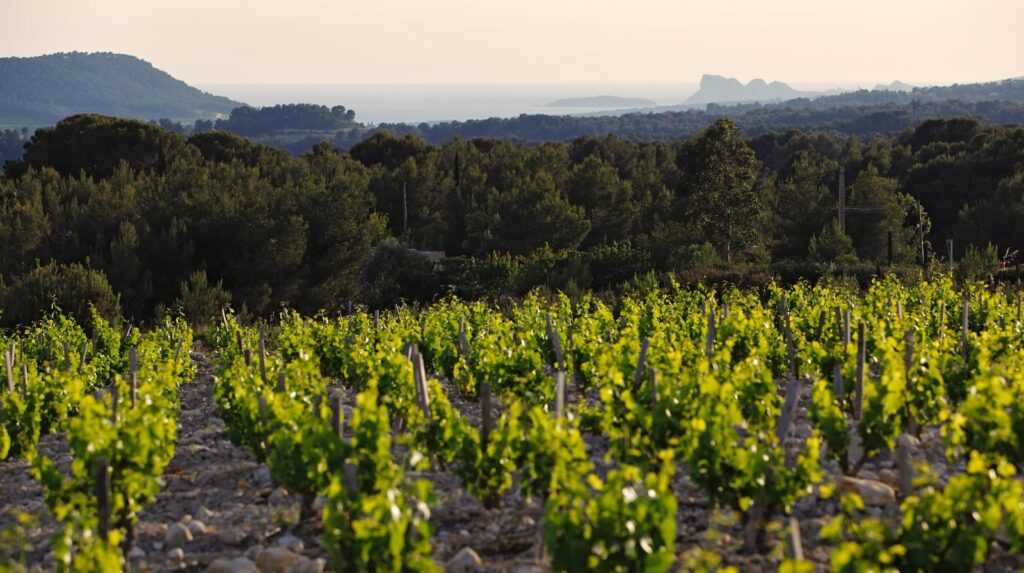
Provence is not all about rosé. Sure, most of its wine is pale, light-bodied rosé, perfect for summer sipping, but there are some stunning red blends. The best place to look for one of these reds is a small appellation called Bandol, located near Toulon on France’s Mediterranean coast.
Bandol’s vineyards are located in an “amphitheater” formed by hills rising from the sea, as you can see in the above picture. This is a hot, dry area, often buffeted by the powerful and cool Mistral wind. By law, Bandol’s red wines must contain a minimum of 50 percent Mourvèdre, and these are typically intensely-flavored and lush. Some Bandol reds are almost entirely Mourvèdre, but most are blended with Grenache and Cinsault to smooth out the rough edges.
- Young Bandol red wines are pleasant, almost Syrah-like. After about five years, these wines mature and show leather and gingerbread notes, and the best can be cellared for up to fifteen years.
- Although Bandol’s reputation is based on its full-bodied, Mourvèdre-based reds, it also produces some of Provence’s best rosé.
You won’t find many great Mourvèdre-predominant wines outside of Bandol. That's because Bandol's hot, dry climate is ideal for the late-ripening Mourvèdre grape (known as Monastrell in Spain), which seldom ripens fully in even slightly cooler areas. Bandol reds are full-bodied, high alcohol, low acid wines with high tannins and some finesse.
- The leading Bandol producer is Domaine Tempier. Its owners led the effort to establish Bandol as its own Appellation d’Origine Contrôllée (AOC) in 1941, and they led the fight against uprooting Bandol's Mourvèdre vines. Today, however, because Bandol is a vacation spot, rising property values are pushing out the vines.
Our wine of the week is a 2017 Domaine Tempier "Pour Lulu" Bandol Rouge ($55 retail). "Pour Lulu" means "for Lulu," a woman who turned 100 in the vintage year of 2017. She was born Lulu Tempier and the vineyard was a wedding gift when she married Lucien Peyraud. Domaine Tempier is still owned by the Peyraud family. Pour Lulu is made from 75 percent Mourvèdre and 14 percent Grenache, with the balance being mostly Cinsault. The wine is aged in large oak casks for 18 months, and is labeled as “11 – 14” percent alcohol, but the alcohol level plainly is at the top of that range. This dark purple wine features blackberry and herb aromas, and is full-bodied, with soft tannins, medium acid, black fruit and spice notes. Pour Lulu has a long, interesting finish. The bottom line: we really liked this wine and thought that it was well worth the money.
- Ideally, you should decant it for at least a half hour. Mourvèdre tends to have some funky aromas that dissipate as it opens up. (These aromas are sometimes described as "barnyard," but would you really drink a wine that smells like a barnyard?)
- While it is pleasant by itself, it deserves to be paired with a meal with some spice and intensity. We loved it with steak and seasoned vegetables, and it would be nice with pasta.
- Domaine Tempier also produces a Mourvèdre-based rosé, which can age for a decade, unlike typical, lighter rosés which should be consumed within a year or so. Tempier also produces the Bandol Rouge Cabassaou, a big, tannic wine made from 95 percent Mourvèdre.
Finally, a couple of housekeeping matters. After Memorial Day, we’ll switch to a bi-weekly blog for the summer months. And, if you’re enjoying the blog, please mention us to your wine-loving friends and suggest that they sign up.
Cheers!
